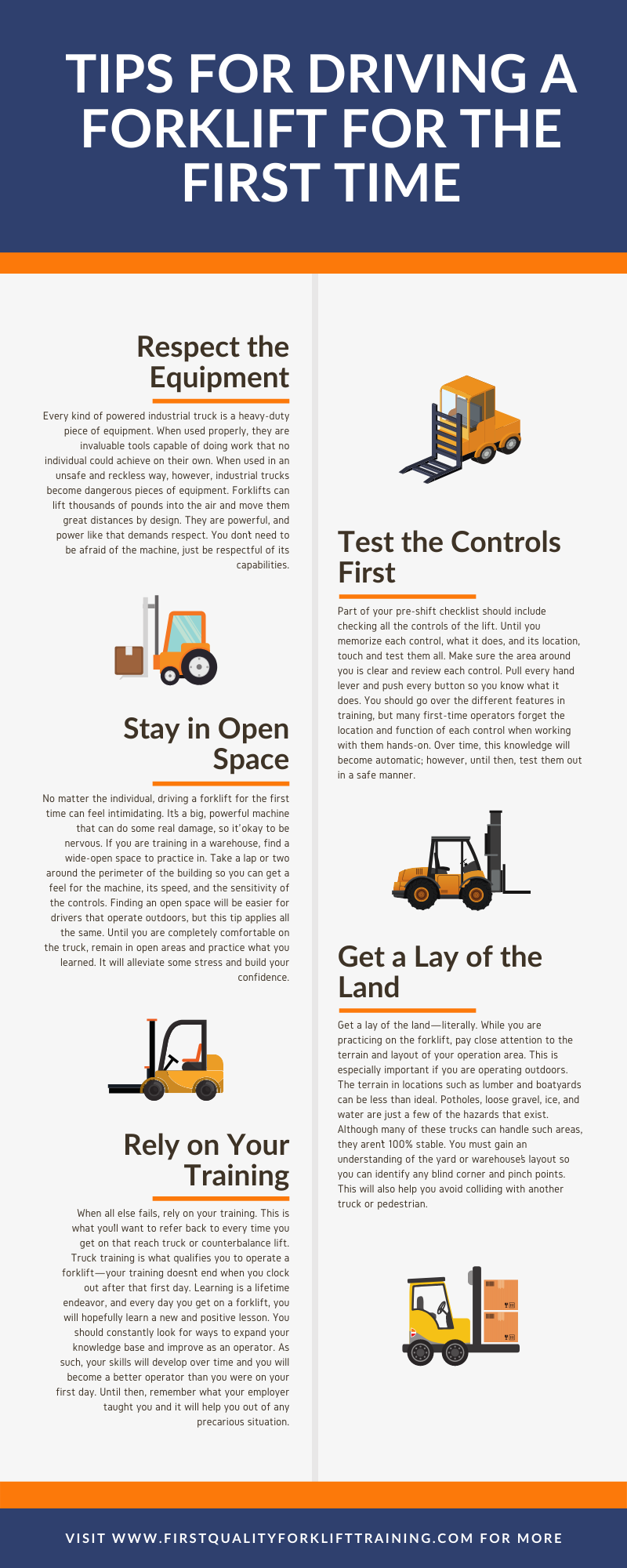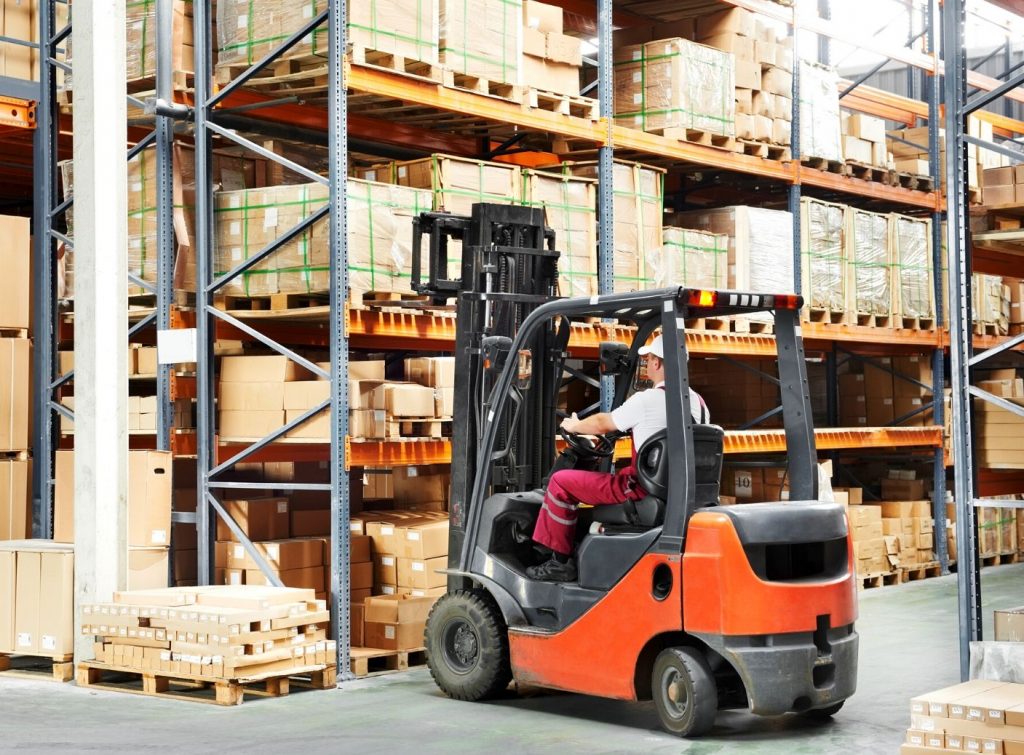Forklift Training
Tips for Driving a Forklift for the First Time
Doing anything for the first time can be scary and stressful. When you start a new job, the first week will likely be stressful. That is until you get to know your coworkers, the flow of operations, and your job responsibilities. Further, if that new job involves learning a completely new skill, your stress level can easily double.
If you’re training to become a forklift operator, a healthy dose of nerves is a good thing. To help you master your fears, we compiled some tips for driving a forklift for the first time to set you up for success. It’s important to note that these tips are a guideline—you should use them alongside a training and certification course. The combination of tips and training will put you a step ahead once you start operating a forklift. Never operate a forklift until you first speak with and get approval from your supervisor or company representative.
OSHA States the following:
- 1910.178(l)(2)(i)
Trainees may operate a powered industrial truck only: - 1910.178(l)(2)(i)(A)
Under the direct supervision of persons who have the knowledge, training, and experience to train operators and evaluate their competence; and - 1910.178(l)(2)(i)(B)
Where such operation does not endanger the trainee or other employees.
Respect the Equipment
Every kind of powered industrial truck is a heavy-duty piece of equipment. When used properly, they are invaluable tools capable of doing work that no individual could achieve on their own. When used in an unsafe and reckless way, however, industrial trucks become dangerous pieces of equipment. Driving a forklift is like driving a car or truck in that aspect. If you wouldn’t do it in your car, don’t do it on a forklift. Forklifts can lift thousands of pounds into the air and move them great distances by design. They are powerful, and power like that demands respect. You don’t need to be afraid of the machine, just be respectful of its capabilities.
Test the Controls First
Part of your pre-shift checklist should include checking all the controls of the lift. Until you memorize each control, what it does, and its location, touch and test them all. Make sure the area around you is clear and review each control. Pull every hand lever and push every button so you know what it does. You should go over the different features in training, but many first-time operators forget the location and function of each control when working with them hands-on. Over time, this knowledge will become automatic; however, until then, test them out in a safe manner.
Stay in Open Space
No matter the individual, driving a forklift for the first time can feel intimidating. It’s a big, powerful machine that can do some real damage, so it’ okay to be nervous. If you are training in a warehouse, find a wide-open space to practice in. Take a lap or two around the perimeter of the building so you can get a feel for the machine, its speed, and the sensitivity of the controls. Finding an open space will be easier for drivers that operate outdoors, but this tip applies all the same. Until you are completely comfortable on the truck, remain in open areas and practice what you learned. It will alleviate some stress and build your confidence.
Get a Lay of the Land
Get a lay of the land—literally. While you are practicing on the forklift, pay close attention to the terrain and layout of your operation area. This is especially important if you are operating outdoors. The terrain in locations such as lumber and boatyards can be less than ideal. Potholes, loose gravel, ice, and water are just a few of the hazards that exist. Although many of these trucks can handle such areas, they aren’t 100% stable. You must gain an understanding of the yard or warehouse’s layout so you can identify any blind corner and pinch points. This will also help you avoid colliding with another truck or pedestrian.
If You Don’t Know, Ask Someone
This adage applies to any job, anywhere, and any time. If you don’t know how to do something, ask someone for help. When you try to figure it out on your own, the odds of you failing increase, and this will only draw unwanted attention to yourself. Plus, not knowing how to operate controls on a lift truck can lead to an accident or severe injuries. For example, if you don’t know how to switch out the gas tank on your truck, ask. A mistake made while changing a propane tank can be life-changing—and not in a good way. However, you also want to make sure you’re not asking the same question over and over again. Ask it once, and if you have to ask again, write down the answer. Coworkers are patient and are willing to help to a point—just don’t waste their time by continually asking the same thing.
Be Safe—Always
Every shift, every day and every time you get on a forklift, be safe. We can’t stress this enough. A forklift is a powerful and fast machine that can cause damage and injuries if used improperly. The temptation to misuse a forklift or horse around with it is always there. Resist the temptation for the sake of your job and health. Always follow best practices when operating a forklift. Never lift a person on your forks, never travel with your view obstructed and never travel with a load more than a few inches off the ground. If you see hazards and obstructions in your path stop the truck get off and remove it. Do it so that you are safe first but do it so the next person to come along doesn’t strike the hazard and have an accident.
Rely on Your Training
When all else fails, rely on your training. This is what you’ll want to refer back to every time you get on that reach truck or counterbalance lift. Truck training is what qualifies you to operate a forklift—your training doesn’t end when you clock out after that first day. Learning is a lifetime endeavor, and every day you get on a forklift, you will hopefully learn a new and positive lesson. You should constantly look for ways to expand your knowledge base and improve as an operator. As such, your skills will develop over time and you will become a better operator than you were on your first day. Until then, remember what your employer taught you and it will help you out of any precarious situation.




You made some great points about how to use a forklift safely. Thanks for mentioning that no matter how strong the temptation is to mess around on this piece of equipment, it is important to always take it seriously and to be careful with what you are doing. I would imagine that finding a trustworthy company that produces safe and reliable forklifts would be a great first step to ensuring safety in the workplace.